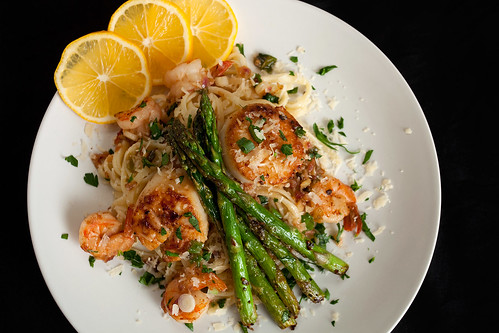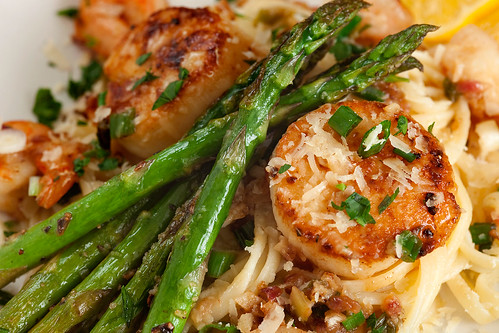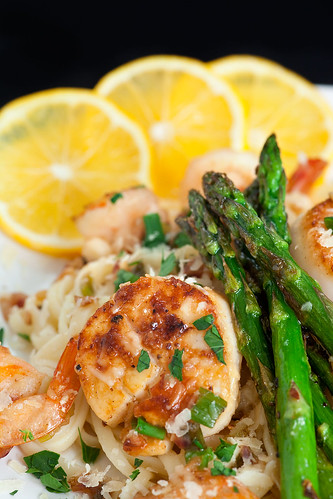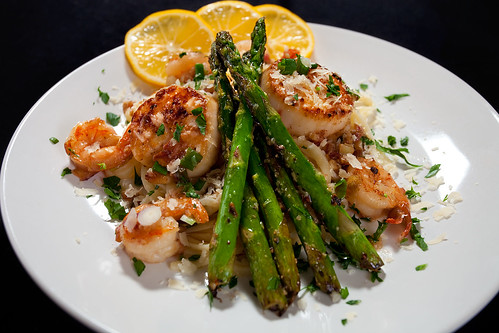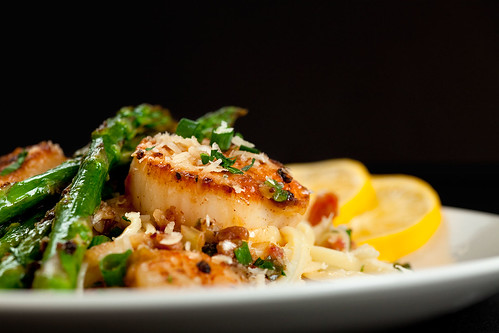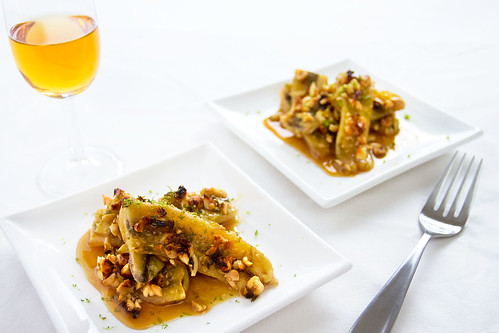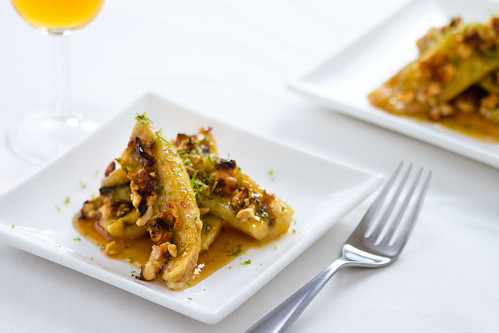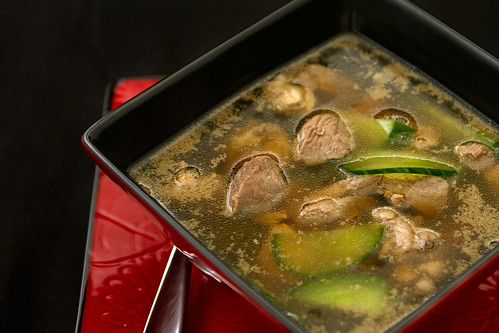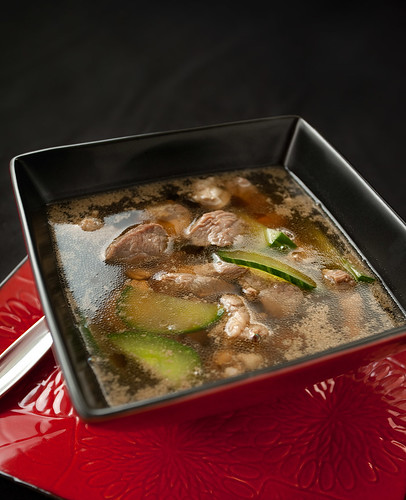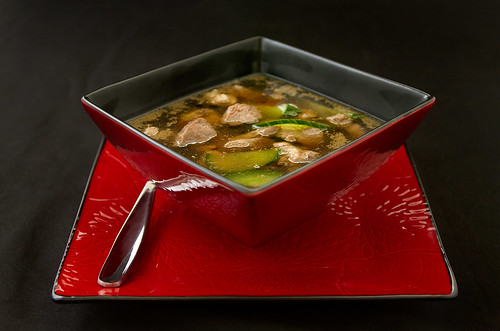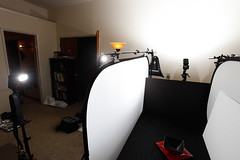You couldn't ask for a better dish - it had many of my favorite food groups: the pasta, shrimp, scallop and asparagus food groups. It even had some grated Parmesan cheese on it!
The Food (Jhan)
This dish came about partly because we had both shrimp and scallops that needed to be used and also because the dish combines some of our favorite foods. The secret of this dish is to make sure that the shrimp and scallops are completely dry before cooking them; they'll get a nice carmelization that way. Make sure your pasta is on before you start cooking the seafood as the scampi cooks quickly. (The asparagus should also be in the oven roasting.)
Melt 1/4 cup of butter in a heavy skillet until it just starts to brown, add in the seasoned (salt and pepper)shrimp and scallops. On high heat, cook about 1-2 minutes on first side, add 4 large cloves of garlic minced, and 4-6 green onions chopped (1/2 in. of the white and 1/2 in. of the green). Turn and cook shrimp and scallops 1-2 minutes more on second side (you may need to do this in two batches). Move the skillet off heat, remove the seafood to a plate, return skillet to heat and add 1/4 cup vermouth and squeeze of a 1/2 lemon. Stir up browned bits on bottom of pan, simmer sauce until thickened and return the shrimp and scallops to the skillet, check seasonings. Drain pasta and plate. Add to skillet 1-2 tbsp chopped Italian parsley, a dash of lemon zest, mix to combine seafood and sauce, arrange over pasta. Add several stalks of the the roasted asparagus to the plate and sprinkle with coarsely grated Parmesan cheese. Serve immediately.
The Plating
For this dish I wanted to go simple, simple, simple. All I wanted was food and plate. No setting, silverware or anything. I took a simple round white plate and put in on a white background.
As to plating the food, I'm still no plating expert. I wanted to try to stack the food like they do in restaurants, so I made a pile of pasta, put a couple of scallops on top, mounded the asparagus spears between the scallops and added some shrimp around the pasta. I added some thin lemon slices for color, but I'm not sure they really add to the plate.
The Lighting and Photography
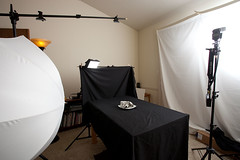 The lighting for this dish was difficult. I wanted to experiment with smaller lights (meaning having smaller lit areas, not smaller flashes), so I used very small light modifier (about 6x9 inches) instead of my usual large reflector or umbrella for the rear light. My thinking was that smaller light sources would mean strong specular highlights on the food, and specular highlights are a big part of the yum factor in food photography (because they make food look juicy, moist and fresh).
The lighting for this dish was difficult. I wanted to experiment with smaller lights (meaning having smaller lit areas, not smaller flashes), so I used very small light modifier (about 6x9 inches) instead of my usual large reflector or umbrella for the rear light. My thinking was that smaller light sources would mean strong specular highlights on the food, and specular highlights are a big part of the yum factor in food photography (because they make food look juicy, moist and fresh).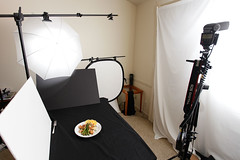 Although I thought this seemed like a good idea, it resulted in a very harsh light in the images I took (see image above). So after doing a large number of shots with this lighting, I reluctantly replaced the small rectangular modifier with an umbrella (see lighting shot below). I also changed the lighting ratio so that more light was coming from the flashes to the right of the dish.
Although I thought this seemed like a good idea, it resulted in a very harsh light in the images I took (see image above). So after doing a large number of shots with this lighting, I reluctantly replaced the small rectangular modifier with an umbrella (see lighting shot below). I also changed the lighting ratio so that more light was coming from the flashes to the right of the dish.These changes resulted in a softer overall lighting, but fewer specular highlights. I think I needed to spend more time repositioning the lights in order to maximize the reflective angles to get more of those juicy highlights to appear.
I also played with the height of the key lights to the right of the dish. Though they were bounced off a sheet, raising or lowering the lights had a real affect on the lighting. When the lights were high, I got somewhat flatly lit images like the one below. But when I moved the lights down (only did this for the last few shots), I got much more interesting side light (see the image at the top of the post).
Lessons Learned
One lesson Jhan and I keep forgetting is that we need to make just enough food for the shoot first, and have her cook the rest while I shoot. That way there is at least some fresh hot food.
Another lesson I learned was to pay more attention to the exact angle of rear lights so that I make sure to maximize the specular highlights that appear in the images. Also, small light sources don't necessarily mean more or better highlights.
Finally, I learned that placing the lights lower and create a more interesting side light - just as having the sun low near the horizon makes more interesting lighting in landscape photography.
